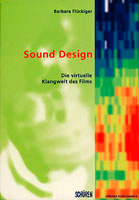Barbara Flueckiger (2001)
Sound Design - Die virtuelle Klangwelt des Films
English synopsis | --> German synopsisMarburg: Schueren.
2001, 2nd edition 2002, 3rd edition 2007, 4th edition 2010, 5th edition 2012
ISBN 3-89472-506-0
In the mid-seventies the aesthetic vocabulary of sound effects in American mainstream films began to change dramatically. Screaming jets flew all around the audience and ghostly helicopters were heard out of nowhere; the Dolby logo appeared on the screens and formerly unknown collaborators were called sound designers. A generation of sound conscious filmmakers like Francis Ford Coppola, George Lucas or Martin Scorsese discovered the suggestive power of sound.
"Sound Design - Die virtuelle Klangwelt des Films" describes recent developments in the sound design of American films, and creates an understanding for the complex architecture of contemporary sound tracks.
"Sound Design" by Barbara Flueckiger is established as standard textbook on this topic in German language.
Synopsis
The systematic research was based on a precise and database-driven analysis of 96 films, primarily US American mainstream productions. Attention is focused on sound design, that is, the compositional work with those elements of the soundtrack that are commonly referred to as sound effects and for which the composer Pierre Schaeffer has created the term sound object (objet sonore). Beyond the narrative and aesthetic functions of the sound object, the structural organization of the material at hand was measured and checked on the basis of hypotheses from perception psychology and psychoacoustics. Interviews with some of the leading sound designers in the US clarified the relationship between technical innovation and aesthetic production.
The organization of the work takes the vast array of methodologies into account which are necessary to explore the complex subject. Therefore the topics are organized in the manner of a handbook, thoroughly and independently, connecting the theoretical foundations with the corresponding research results. Starting from this concept, the work is divided into five parts with the following topics.
In part 1 Premises two preparatory chapters cover the technical developments and formats as well as the transformation process of sound recording in the age of virtual and abstract sound production.
Semantic dimensions of sound objects are the central focus of part 2 Aspects of Meaning. This includes the identification of sound objects, the sound/image relationship, as well as higher order semantics, so-called supersigns, such as leitmotifs, symbols, or stereotypes.
The third part Tonality covers the psycho-acoustic features of individual stimuli, the percep-tion of complex sound patterns under the aspects Attention and Selection, as well as research on the techniques of sound processing and the musical treatment of natural sound material.
Finally, part 5 Model Analyses uses the acquired analytical instruments to describe three com-plementary strategies by means of selected scenes from the films Jurassic Park (USA 1992, Steven Spielberg), The Silence of the Lambs (USA 1991, Jonathan Demme), and The Right Stuff (USA 1983, Philip Kaufman).
The research has produced a number of new insights:
a significant increase in subjective transformations in a variety of subtle nuances;
the excessive use of extreme frequencies (under 80Hz and above 4000Hz);
the conscious introduction of unidentified sound objects to disorient the spectator and to enhance the tension;
a very careful arrangement of the material qualities on the soundtrack, either in genres like fantasy and science-fiction or to represent the psychological fragility of the protago-nists;
the formation of complete acoustic settings by means of emblematically excessive sound objects;
the abandonment of the traditional alter function of film through the use of excessive volumes, which overwhelm spectators according to simple attraction-reaction patterns and which release direct, cognitively uncontrollable vegetative reactions;
the emancipation of the acoustic from the visual representation, which, among other things, leads to the fact that central characters, situations, or settings can be presented purely acoustically, based on the assumption that the media savvy spectator is able to decipher complex stimuli;
the extension of the sound space into all four quadrants of the film theater and the plasticity of the geometric sound/image relationship.
Unique Selling Points
The literature on sound design can be divided into two main categories. Publications either target a readership of practitioners and are therefore instructional manuals, or they emerge in the field of film and media studies and neglect the technological and psycho-acoustic aspects to a high degree. Sound Design is the first book which connects deep insights into the tech-nology with a theoretical reflection on epistemological, aesthetic and narrative facets in con-junction with a bottom-up analysis of a vast group of films. Its scope is to translate techno-logical knowledge for the humanities, in order to investigate its consequences on form and content from an interdisciplinary perspective.
Each chapter is self-contained by integrating all the necessary information, which makes it possible to read individual chapters only. Cross references and a glossary help to close possi-ble gaps.
Market Potential
The book aims at a large target readership consisting of:Film and media scholars
Film practitioners
Interested laypersons
Film students
Sound Design is established as a standard textbook for academic and practical courses in the German speaking countries.
